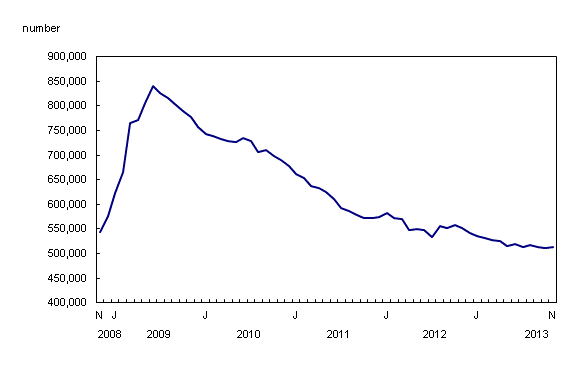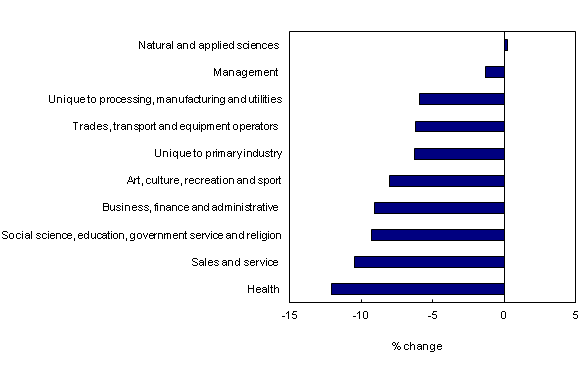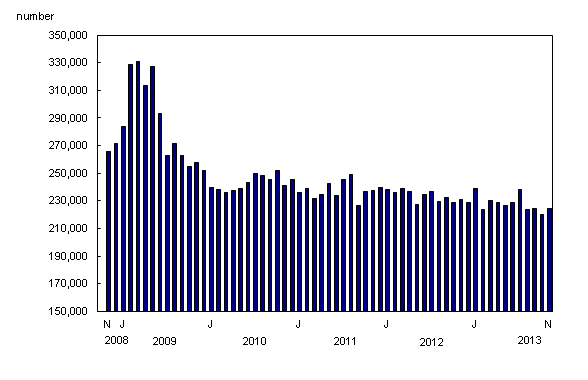Employment Insurance, November 2013
Archived Content
Information identified as archived is provided for reference, research or recordkeeping purposes. It is not subject to the Government of Canada Web Standards and has not been altered or updated since it was archived. Please "contact us" to request a format other than those available.
Released: 2014-01-23
There were 512,300 people receiving regular Employment Insurance (EI) benefits in November, virtually unchanged from October. The number of beneficiaries has been relatively stable since May 2013.
Provincially, Prince Edward Island, Nova Scotia and New Brunswick saw more people receiving regular EI benefits in November compared with October. At the same time, there was little change in the other provinces.
The change in the number of regular EI beneficiaries reflects various situations, including people becoming beneficiaries, people going back to work, and people who no longer receive regular benefits.
Provincial and metropolitan area overview
The number of people receiving regular EI benefits in Prince Edward Island increased 2.4% from October to November, continuing the upward trend that started last August.
In Nova Scotia, the number of beneficiaries rose by 1.6% in November, the second increase in the past three months. The number of beneficiaries in Halifax rose by 2.0% in November, similar to the increase the month before.
The number of regular EI beneficiaries was up slightly (+1.2%) in New Brunswick, following a decline in the previous month. In Saint John, the number increased by 2.8% in November, while there was a slight decline (-1.1%) in Moncton.
The number of beneficiaries was little changed in the other provinces. However, this was not the case in some of the metropolitan areas within these provinces.
In Newfoundland and Labrador, the number of beneficiaries in the metropolitan area of St. John's increased 10.4% in November, offsetting some of the declines in the previous two months.
In Quebec, there were slight declines in the metropolitan areas of Gatineau, Montréal and Trois-Rivières. There were small increases in the metropolitan areas of Saguenay and Québec.
Ontario had more regular EI beneficiaries in three metropolitan areas in November, most notably Oshawa, where the number of beneficiaries rose by 5.6%. There were also more beneficiaries in Kitchener–Cambridge–Waterloo and Greater Sudbury. At the same time, there were fewer beneficiaries in St. Catharines–Niagara and Brantford.
In Regina, the number of beneficiaries increased slightly in November following six consecutive months of decline. In turn, Saskatoon saw fewer beneficiaries for the seventh month in a row.
In Calgary, the number of beneficiaries fell by 3.5% in November, the fourth consecutive monthly decline. In Edmonton, the number increased by 3.2%, after falling in the previous two months.
The number of beneficiaries in Kelowna rose by 4.4% in November, following two consecutive months of decline. In Abbotsford–Mission, the number declined by 5.2% after a sharp increase in October. The number of beneficiaries in Vancouver increased slightly.
Regular Employment Insurance beneficiaries by occupation
Of the 10 major occupation groups, art, culture, recreation and sports posted a slight decline in the number of beneficiaries in November, while occupations unique to primary industry and those in trades, transport and equipment operation recorded slight increases. There was little change in all other occupation groups.
On a year-over-year basis, there were fewer beneficiaries in all occupation groups, except natural and applied science. The most notable declines occurred in health occupations (-12.1%) and in sales and service (-10.5%).
Employment Insurance beneficiaries in major demographic groups
For the second consecutive month, there were more men aged 55 and over receiving regular EI benefits, up 2.2% in November. In contrast, there were fewer beneficiaries among young men aged 15 to 24 (-1.6%), marking the second consecutive monthly decline. There was little change in the number of women receiving benefits across all age groups.
On a year-over-year basis, women receiving regular EI benefits in all age groups continued to experience faster rates of decline than men.
More Employment Insurance claims in November
The number of claims provides an indication of the number of people who could become beneficiaries.
Following a decline in October, the number of initial and renewal claims rose by 1.9% in November to 224,500. Compared with November 2012, claims fell by 3.0%.
Provincially, the number of claims increased by 9.4% in Newfoundland and Labrador, 7.5% in Nova Scotia, 4.8% in Manitoba, 4.7% in Quebec, and 3.4% in New Brunswick. However, the number of claims declined by 3.3% in British Columbia and fell slightly in Saskatchewan (-1.1%). There was little or no change in the other provinces.
Note to readers
Regular Employment Insurance (EI) benefits are available to eligible individuals who lose their jobs and who are available for and able to work, but can't find a job. To receive EI benefits, individuals must first submit a claim. The number of claims provides an indication of the number of people who could become beneficiaries.
There is always a certain proportion of unemployed people who do not qualify for benefits. Some unemployed people have not contributed to the program because they have not worked in the past 12 months or their employment is not insured. Other unemployed people have contributed to the program but do not meet the eligibility criteria, such as workers who left their job voluntarily or those who did not accumulate enough hours of work to receive benefits.
All data in this release are seasonally adjusted. For more information on seasonal adjustment, see Seasonal adjustment and identifying economic trends.
EI statistics are produced from administrative data sources provided by Service Canada and Employment and Social Development Canada. These statistics may, from time to time, be affected by changes to the Employment Insurance Act or administrative procedures. Recent examples are the pilot project entitled "Working While on Claim," introduced on August 5, 2012, and the regulation on search for suitable employment, that came into effect on January 6, 2013.
The number of regular EI beneficiaries and the number of claims received for the current and previous month are subject to revision.
The number of beneficiaries is a measure of all people who received EI benefits from November 10 to 16. This period coincides with the reference week of the Labour Force Survey (LFS).
EI statistics indicate the number of people who received EI benefits, and should not be confused with LFS data, which provide information on the total number of unemployed people.
Data tables are also now available online. From the Browse by key resource module of our website under Summary tables, choose Subject, then Labour.
Data on Employment Insurance for December 2013 will be released on February 20.
Contact information
For more information, contact us (toll-free 1-800-263-1136; 514-283-8300; infostats@statcan.gc.ca).
To enquire about the concepts, methods or data quality of this release, contact Vincent Ferrao (613-951-4750; vincent.ferrao@statcan.gc.ca), Labour Statistics Division.
- Date modified:




